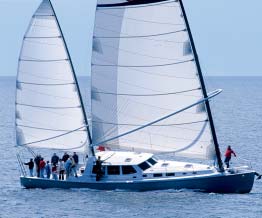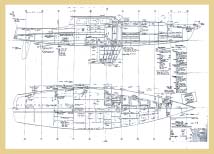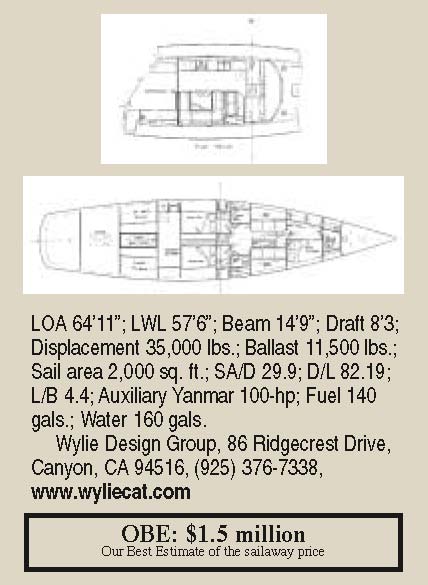|
|
Wyliecat 65 Offshore cruiserOridginally published in Sailing magazine, September 2004
This unique Tom Wylie design started life as a custom research vessel project for the Wyliecat group but ground to a halt when the funds got thin. So the boat was put out to pasture. Literally. Then along came Randy Repass, owner of West Marine. Randy was interested in a new boat and had been following the big Wylie project with casual interest. Randy came up with the idea that he would finance the completion of the first Wyliecat 65 as a research vessel and buy a second boat as his private cruising yacht. Heck of an idea. What a guy. Derek M. Baylis is now operating as an educational vessel for oceanographic and marine biological studies. Randy and his wife Sally Christine are off somewhere in the Pacific cruising in their boat.No question, this is a boat you are either going to like or not. It’s a strong design statement with some challenging aesthetic issues. I happen to like it and I think that once you begin to understand the versatility of this design you may not ever think it’s good looking, but you will appreciate its overall design and pragmatic approach. Tom’s boats perform well. They always have. That’s a given here with this new design. The D/L is 82.19 and the L/B is 4.4, indicating a narrow, light boat. I’m using the published displacement of 35,000 pounds for my calculations. The Repass model is considerably heavier than the research vessel model and is outfitted as an offshore, long-range cruising vessel. The hull shows short ends and minimal rocker, as you would expect given the low displacement. Draft is 8 feet, 3 inches. The keel is a lead bulb on a welded steel fin. The keel fin holds 105 gallons of fuel. There is nothing very unusual in this hull form. When the D/L gets this far below 100 there is not much shape to play with. Derek M. Baylis is designed to sleep 10 if you don’t use the pilothouse dinette. The galley is in the pilothouse. The dinette looks big enough for six people to dine comfortably but four more can eat at the drop-leaf table down in the saloon. There are three heads and if you have a parcel of school kids out for an afternoon of rocking and rolling at sea three heads is probably a good idea. A large amount of the available hull volume is devoted to cargo space and stowage areas so the boat can be loaded with equipment for offshore scientific studies.The focal point of this design is the deck layout. There are twin wheels forward in the long cockpit. The pilothouse looks very high but this height allows the staterooms to extend under the pilothouse sole. The transom is essentially a carbon fiber drop-board that is removable, and this opens up the entire stern of the boat so you can drag a large inflatable aboard and divers can come and go easily. The removed transom is the exact same camber as is the top of the pilothouse, so the transom can be stowed almost flush on top of the pilothouse. Nice touch, Tom. There is a deep well deck forward of the main mast. The rig is a type that Tom has been working on for years. He’s sold on the ease of operation and he’s convinced that you can’t run a vessel like this with multiple day trips with any other rig. The high stern arch gets the aft sheet out of the way and above heads during a jibe. The carbon, free-standing
masts keep overall rig weight down. The SA/D is a healthy 29.9, but it has to be high with this rig because there are no jibs or chutes to augment the rig when it gets light. We’ll just have to wait and see if this is the ultimate offshore rig. I prefer stayed rigs for offshore work.
Marine built both of these 65-footers. They are great builders and a favorite of mine. Structures are high-tech with carbon fiber used extensively to help keep the weight down. Derek M. Baylis has the look of a serious workboat. I have always loved boats with their roots in the world of workboats. Nice job, Tom. Thanks, Randy.
SAILING 2004 SEPTEMBER |
||||||


